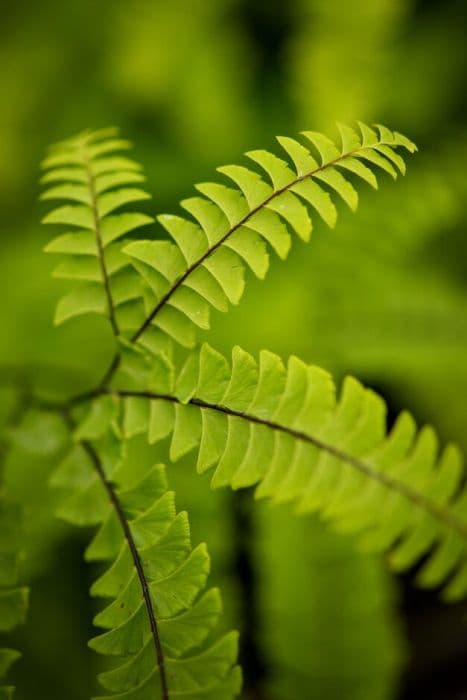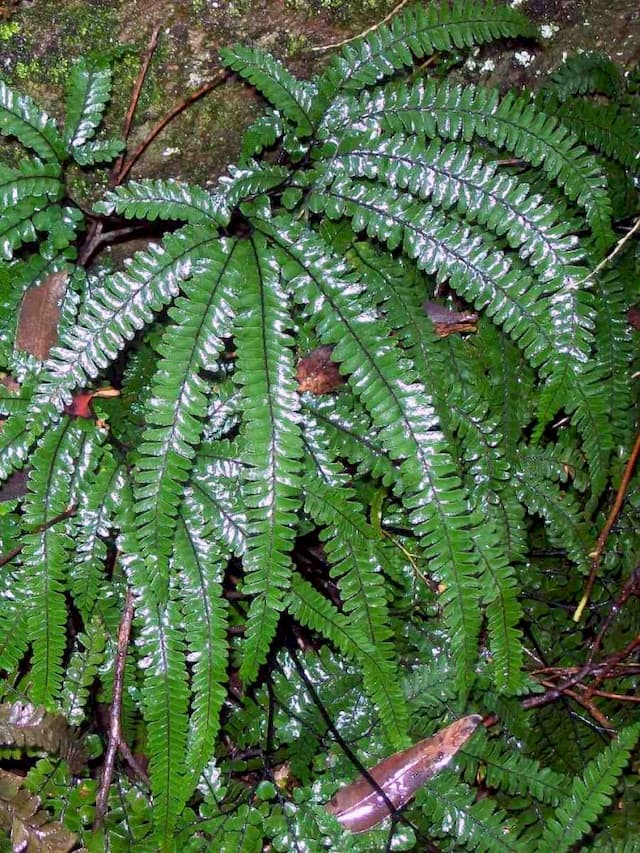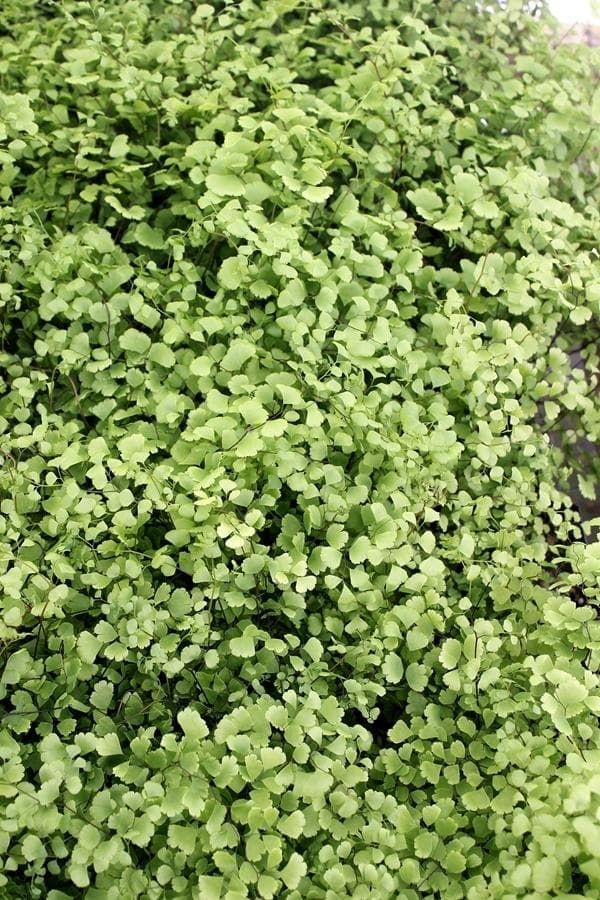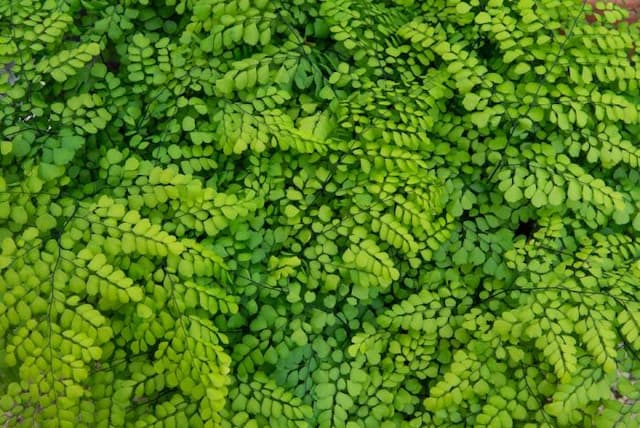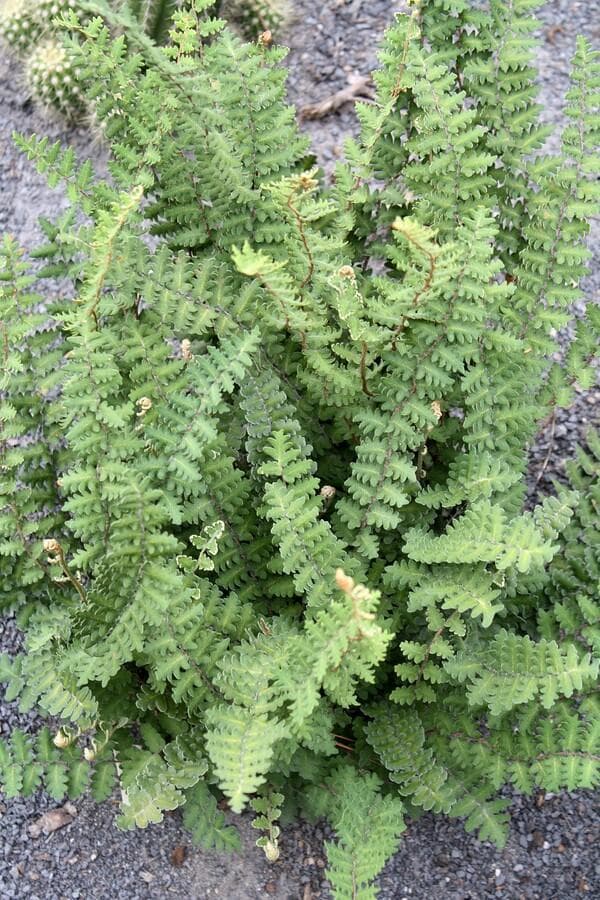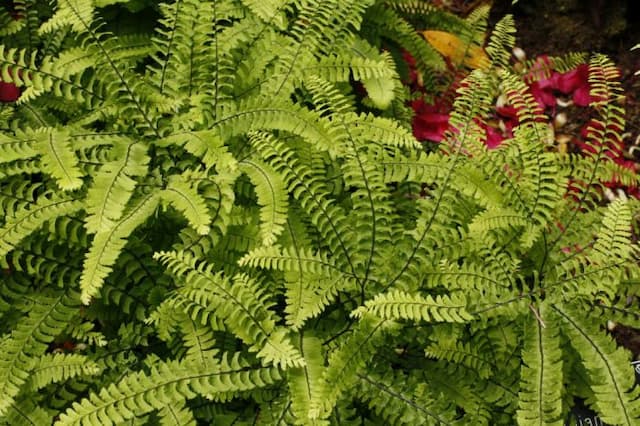Northern Maidenhair Fern Adiantum pedatum L.

ABOUT
The commonly known as Northern maidenhair fern, is an attractive and delicate-looking plant. It boasts a distinctive and elegant appearance with its fronds that are divided into smaller leaflets, giving them a feather-like look. The stems stand out with their glossy, dark purple to black color, providing a striking contrast with the light green, almost translucent leaflets. These leaflets are arranged in a fashion to create a circular or fan-like shape, adding to the fern's ornamental appeal. The leaflets themselves are gently curved, with the edges slightly lobed or toothed, contributing to a soft and intricate texture. The pattern in which the leaflets are arrayed is also unique; they are typically grouped in opposing pairs along the fine, wiry stems. The overall impression is one of graceful symmetry and fine, lacy detail. As the plant matures, the stems can become more curved, allowing the circular arrangement of the leaflets to be displayed to full advantage. In its natural habitat, the plant tends to grow in clusters, forming lush sweeps of greenery. The fine-textured foliage can create an ethereal feel when rustled by the breeze, casting dainty shadows on the ground below. The plant's aesthetic allows it to fit well in shaded garden areas where it can add a touch of elegance and lightness amidst other plants.
About this plant
 Names
NamesFamily
Pteridaceae
Synonyms
Northern Maidenhair Fern, Five-fingered Fern, American Maidenhair Fern, Maidenhair Fern
Common names
Adiantum pedatum var. aleuticum Rupr., Adiantum pedatum var. calderi Cody, Adiantum pedatum f. dissectum R.T.Clausen, Adiantum pedatum var. kamtschaticum Rupr., Adiantum aleuticum (Rupr.) C. A. Paris.
 Toxicity
ToxicityTo humans
The common name of Adiantum pedatum L. is Maidenhair Fern. This plant is generally considered non-toxic to humans. There are no well-documented cases of poisoning from ingesting any part of the Maidenhair Fern, and it is not known to cause adverse reactions when handled or consumed in typical amounts. However, it is always advisable to exercise caution and avoid ingesting plants that are not specifically intended for human consumption as individual allergic reactions or sensitivities can occur.
To pets
Maidenhair Fern, the common name for Adiantum pedatum L., is also non-toxic to pets. There are no significant reports of toxicity or poisoning in domestic animals such as cats and dogs from consuming this plant. As with humans, it's always best to keep an eye on pets to prevent them from eating large quantities of any non-food plants, as they could potentially cause an upset stomach or an unexpected allergic reaction, but Maidenhair Fern is not widely recognized as a toxic species to pets.
 Characteristics
CharacteristicsLife cycle
Perennials
Foliage type
Deciduous
Color of leaves
Green
Height
1-1.5 feet (30-45 cm)
Spread
1-1.5 feet (30-45 cm)
Plant type
Herb
Hardiness zones
3-8
Native area
North America
Benefits
 General Benefits
General Benefits- Ornamental Value: Maidenhair Fern adds aesthetic appeal to gardens, terrariums, and indoor spaces with its delicate fronds and unique fan-shaped leaf patterns.
- Shade Tolerance: This fern thrives in shady conditions where other plants may not grow as well, making it ideal for forest underplantings or dark corners of the garden.
- Humidity Tolerance: Maidenhair Fern can tolerate and thrive in humid conditions, which makes it well-suited for bathrooms and kitchens, where it can contribute to a lush ambiance.
- Wildlife Habitat: The dense fronds of the Maidenhair Fern provide shelter and breeding places for a variety of insects, which in turn can attract birds and other wildlife.
- Soil Erosion Control: With its network of roots, Maidenhair Fern helps to stabilize soil in shaded areas, reducing the impacts of erosion from wind or water.
- Low Maintenance: Once established, Maidenhair Fern generally requires minimal care beyond keeping the soil consistently moist, making it a good plant for novice gardeners.
- Naturalistic Landscaping: Incorporating Maidenhair Fern into a naturalistic landscape can enhance its authenticity and beauty, as the plant contributes to a woodland or forest feel.
- Versatility in Landscaping: The plant can be used in various landscaping designs, including rock gardens, borders, or as ground cover in appropriately moist and shaded areas.
- Seasonal Interest: Maidenhair Fern offers visual interest throughout the growing season with its new fronds uncurling in the spring and providing a lush green appearance during summer and fall.
 Medical Properties
Medical Properties- Expectorant - Historically used to help loosen phlegm and relieve cough.
- Astringent - Used for its tightening properties on tissues, potentially aiding in wound healing.
- Diuretic - Thought to promote the excretion of urine, aiding in the removal of excess water from the body.
- Demulcent - May soothe irritated or inflamed internal tissues.
- Anti-inflammatory - Containing compounds that could reduce inflammation.
- Antioxidant - Potentially contains compounds that fight free-radical damage.
 Air-purifying Qualities
Air-purifying QualitiesThis plant is not specifically known for air purifying qualities.
 Other Uses
Other Uses- Decorative Crafts: Maidenhair fern can be used in floral arrangements and wreaths due to its delicate foliage and unique texture.
- Fairy Gardens: With its fine leaves and graceful appearance, the plant is a popular choice for creating whimsical fairy garden landscapes.
- Dye Production: The leaves of Maidenhair fern have historically been used to create a natural yellow-green dye for textiles.
- Water Quality Indicator: Maidenhair fern can be an indicator of high water quality as it grows best in areas with clean, non-contaminated water sources.
- Photography Subjects: Due to their intricate fronds and structural beauty, Maidenhair ferns are often used as subjects in macro photography.
- Education: This fern species can be employed in botany classes to teach about plant morphology and reproduction, particularly about fern life cycles.
- Soil Erosion Prevention: Maidenhair fern can help prevent soil erosion when planted on slopes or in areas with loose soil.
- Shade Gardens: The fern is ideal for shade gardens, providing understory texture and ambiance in landscaping beneath trees or other larger plants.
- Culinary Garnishing: While not an edible plant, its attractive foliage can be used as a non-toxic decorative garnish for plating dishes in high-end culinary settings.
- Performance Art: Occasionally, the unique form of the Maidenhair fern is incorporated into the visual aesthetics of performance arts, like dance and theatre set designs.
Interesting Facts
 Feng Shui
Feng ShuiThe Maidenhair Fern is not used in Feng Shui practice.
 Zodiac Sign Compitability
Zodiac Sign CompitabilityThe Maidenhair Fern is not used in astrology practice.
 Plant Symbolism
Plant Symbolism- Femininity: The delicate and feathery fronds of the Northern Maidenhair Fern, a common name for Adiantum pedatum L., often symbolize softness and grace, qualities traditionally associated with femininity.
- Secret Bond of Love: The intricate patterns of the fern's leaves are sometimes thought to represent the complexity and hidden depths within a romantic relationship.
- New Beginnings: Ferns, in general, are considered emblematic of new growth and new beginnings due to their ability to thrive in challenging environments and their role in forest regeneration after disturbances.
- Eternal Youth: The freshness and seemingly everlasting green of the fern's foliage symbolize eternal youth and the desire for everlasting beauty.
- Shelter: The dense growth habit of Northern Maidenhair Ferns provides shelter to small forest creatures, making them symbolic of safety, protection, and nurturing.
- Purity: The bright green, untainted color of the fern's leaves can symbolize purity and the unspoiled quality of nature.
 Water
WaterThe Northern Maidenhair Fern (Adiantum pedatum L.) thrives in evenly moist soil, so it requires regular watering to maintain this environment. Provide water when the top inch of soil feels dry, which can vary between once a week to every few days depending on the humidity and temperature conditions. Generally, it may need about half a gallon every week, but this is not fixed and should be adjusted based on the soil's moisture level. Overwatering or allowing the soil to dry out completely can lead to stress and damage to the plant, so ensure the soil stays consistently damp but not waterlogged.
 Light
LightThe Northern Maidenhair Fern requires bright, indirect light to flourish. This plant is suitable for an east- or north-facing window where direct sunlight is limited. Avoid placing the fern in full sun, as its delicate fronds can easily burn. Diffused light that mimics the dappled shade of a forest understory is ideal for maintaining the health and vibrant green color of the fern's fronds.
 Temperature
TemperatureThe Northern Maidenhair Fern prefers moderate temperatures, generally between 60-75°F, and should be protected from extreme temperatures. This fern can tolerate a minimum temperature of down to 50°F but should not be exposed to freezing conditions. The ideal temperature range fosters the best growth and maintains the plant's overall health.
 Pruning
PruningPruning the Northern Maidenhair Fern involves gently removing dead or damaged fronds to maintain the plant's health and appearance. Pruning is best done in the spring before new growth starts so the plant can focus energy on producing fresh fronds. Regularly inspect the plant and prune as needed, but avoid excessive cutting to keep the natural, feathery look of the fern.
 Cleaning
CleaningAs needed
 Soil
SoilThe best soil mix for the Northern Maidenhair Fern (Adiantum pedatum L.) is a well-draining, rich organic potting mix with a pH of 6.0 to 7.5. A blend of peat, perlite, and garden loam can encourage healthy growth. Ensure the mixture retains moisture without becoming waterlogged.
 Repotting
RepottingThe Northern Maidenhair Fern should be repotted every two years to refresh the soil and accommodate root growth. It's best to repot in the spring before the growing season starts.
 Humidity & Misting
Humidity & MistingThe Northern Maidenhair Fern thrives in high humidity environments, preferably above 60% humidity. To maintain these levels indoors, use a room humidifier or place the fern's pot on a tray filled with pebbles and water.
 Suitable locations
Suitable locationsIndoor
Place in bright, indirect light with high humidity.
Outdoor
Shade to part shade, shelter from winds, keep moist.
Hardiness zone
3-8 USDA
 Life cycle
Life cycleMaidenhair Fern (Adiantum pedatum L.) begins its life cycle as a spore, which germinates under favorable moisture and temperature conditions to produce a small, heart-shaped gametophyte (prothallus). This gametophyte houses both male (antheridia) and female (archegonia) reproductive structures. Upon fertilization, the zygote develops into a new sporophyte, which is the familiar fern plant. The young fern grows from a rhizome and produces fronds that uncurl from fiddleheads (croziers) into the mature, typically fan-shaped leaves. As the plant matures, clusters of spore-producing structures called sori form on the undersides of the fronds. When mature, these spores are released to the environment, beginning the cycle anew.
 Propogation
PropogationPropogation time
Spring to Summer
The most popular method of propagation for the Northern Maidenhair Fern (Adiantum pedatum L.) is through division of the rhizomes. This is usually done in early spring before the fronds emerge or in the fall after the growing season has ended. To propagate, carefully dig up the fern, ensuring a large clump of roots and soil are attached. Using your hands or a sharp knife, gently separate the rhizomes into sections, making sure each section has at least one growing point or frond. Replant the divisions at the same soil depth as they were previously growing, spacing them approximately 12 to 24 inches (30 to 61 centimeters) apart to allow room for growth. Water them in well after planting to help establish the new divisions.
